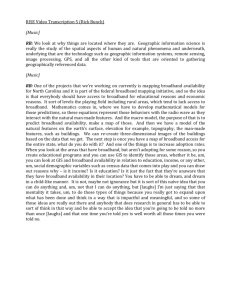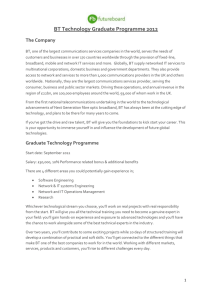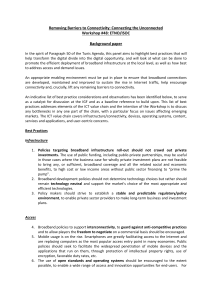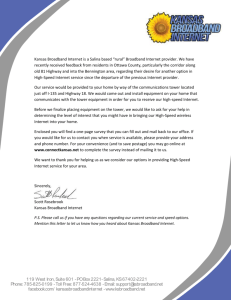A Frequency Decomposition Time Domain Model of Broadband
advertisement
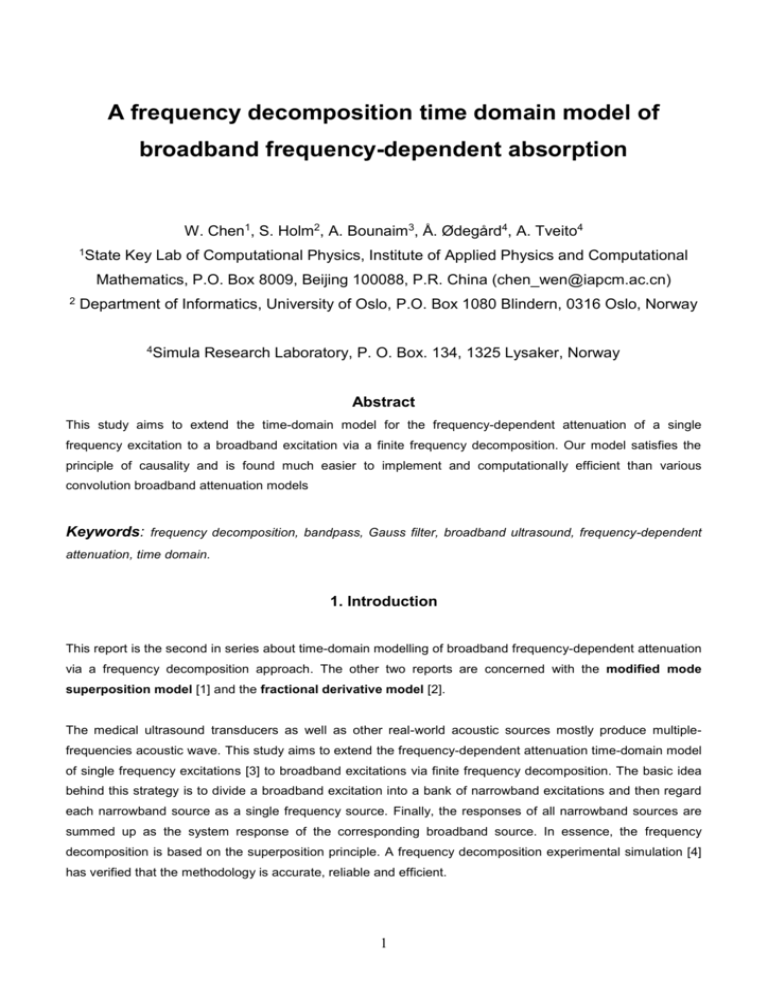
A frequency decomposition time domain model of broadband frequency-dependent absorption W. Chen1, S. Holm2, A. Bounaim3, Å. Ødegård4, A. Tveito4 1State Key Lab of Computational Physics, Institute of Applied Physics and Computational Mathematics, P.O. Box 8009, Beijing 100088, P.R. China (chen_wen@iapcm.ac.cn) 2 Department of Informatics, University of Oslo, P.O. Box 1080 Blindern, 0316 Oslo, Norway 4Simula Research Laboratory, P. O. Box. 134, 1325 Lysaker, Norway Abstract This study aims to extend the time-domain model for the frequency-dependent attenuation of a single frequency excitation to a broadband excitation via a finite frequency decomposition. Our model satisfies the principle of causality and is found much easier to implement and computationally efficient than various convolution broadband attenuation models Keywords: frequency decomposition, bandpass, Gauss filter, broadband ultrasound, frequency-dependent attenuation, time domain. 1. Introduction This report is the second in series about time-domain modelling of broadband frequency-dependent attenuation via a frequency decomposition approach. The other two reports are concerned with the modified mode superposition model [1] and the fractional derivative model [2]. The medical ultrasound transducers as well as other real-world acoustic sources mostly produce multiplefrequencies acoustic wave. This study aims to extend the frequency-dependent attenuation time-domain model of single frequency excitations [3] to broadband excitations via finite frequency decomposition. The basic idea behind this strategy is to divide a broadband excitation into a bank of narrowband excitations and then regard each narrowband source as a single frequency source. Finally, the responses of all narrowband sources are summed up as the system response of the corresponding broadband source. In essence, the frequency decomposition is based on the superposition principle. A frequency decomposition experimental simulation [4] has verified that the methodology is accurate, reliable and efficient. 1 It is expected that the strategy will also work with the FEM time-domain numerical simulation. Compared with the previous mode superposition model [1], the present broadband model also satisfies the principle of causality and is as simple to implement, more computationally affordable since it circumvents computationally expansive fractional power of a matrix. The additional computing effort of this model is to the forward and inverse bandpass filter transforms of broadband excitations, which is trivial among the whole simulation. However, the computing effort of broadband excitations is expected about ten times higher than that of a single excitation. Blessing is that the model is inherently very suitable for parallel computing. The direct extension of the present model to nonlinear media, however, is blocked since the superposition principle ceases to hold. A linearization iteration method [5] may revitalize the model to nonlinear problems, which we will investigate in the future. The rest of the report is grouped into the four sections. In section 2, the time domain model of single frequency excitation is briefly discussed for the completeness of this self-contained report, and then, in section 3, we outline the frequency decomposition procedure to model the ultrasound propagation under a broadband excitation in time domain. Section 4 is dedicated to the bandpass filter which decomposes a broadband excitation into a bank of narrowband excitations. Finally, section 5 analyzes the dispersion properties of the present broadband time domain model. 2. Time-domain model for single frequency excitation The frequency-power attenuation is given by px x px e f x , (1) where p represents the amplitude pressure, and f is the frequency, f 0 f y , y[0,2]. (2) Here 0 is the attenuation constant and y the frequency-power exponent, both of which are dependent on tissues. Assuming the viscous absorption linearly depends on the velocity, the standard time-domain damped ultrasound wave model can be expressed as 1 p p 2 p 0 , 2 c 2 (3) where is the viscous coefficient, and upper dot denotes the temporal derivative. The FEM analogization of spatial Laplacian yields the semi-discretization equations p c 2p c 2 Kp g t , (4) where K is the symmetric FEM interpolation matrix of Laplace operator, and vector g(t) is due to the external excitation source (transducers on boundary surface of our problems). In the case of a singular frequency excitation g(t), [1] derived p 2 0 cf y p c 2 Kp g t (5) corresponding to the empirical frequency-dependent absorption (1). In the preceding superposition model report [1], it is shown that (5) satisfies the causality principle. 3. Frequency decomposition time domain scheme If the external source is a broadband excitation s(t) instead of a single frequency g(t) in (4), the models (4) and (5) can not hold with the frequency-dependent attenuation (2) except when y=0. [3] suggested using the central frequency of s(t) as a single frequency in determining the viscous coefficient, and then the formulation (5) is applied. In some cases, this procedure may introduce unpredictable significant model error. Following the frequency decomposition idea presented in [4], a more accurate alternative scheme should be to decompose the broadband excitation s(t) into a sum of narrowband excitations si(t), i.e. m s t si (t ) . (6) i 1 When the bandwidth of each component is narrow enough, the attenuation effect can be simulated at the center frequency of each narrowband component [4]. Then, the model (5) for single frequency excitation is applied to each narrowband component source si(t) with their respective central frequency, and we get m sets of semi-discrete FEM system equation pi 2 0 cf i y p i c 2 Kpi si t , (7) which fi is the central frequency of si(t). Although the FEM discretization for matrix K is only done once for all, the repeated solution of m sets of ordinary differential equation systems (7) is quite time-consuming given that each (7) is a semi-discrete FEM equation of large ODEs. The parallel solution of all temporal ordinary equation sets (7) could be crucial to improve the efficiency. 3 s(t) B1(f) s1(t) p1(t) Bi(f) si(t) pi(t) Bm(f) sm(t) pm(t) p(t) Fig. 1. Schematic procedure of frequency decomposition time domain model In terms of the superposition principle under the linear system, the response of a broadband excitation s(t) is a sum of those of all of its narrowband component excitations m p t pi (t ) . (8) i 1 (6), (7) and (8) outline the basic methodology of the present scheme. Fig. 1 illustrates the schematic solution procedure via the frequency decomposition of a broadband pulse. The major sources of error of the present mathematical model are 1) the central frequency of narrowband component source in (7) is approximately used as in the single frequency case; 2) the formulation (5) for single frequency excitation itself is also an approximate analog of the damping effect which ignores the transient solution. Since there is no need to calculate the fractional power of matrix K, the present model is computationally more efficient compared with the mode superposition model given in [1]. However, the present model also faces a new computing challenge: the repeated (about ten times) solution of ODEs (7) for all narrowband responses. 4 4. Bandpass filters for frequency decomposition This section addresses the bandpass filter issue, a key part of the present broadband time domain model. The filter is to perform frequency-dependent alterations of a signal, i.e. filtering. As shown in Fig. 1, a set of the bandpass filter Bi(f) divide the broadband s(t) into a sum of narrowband si(t). One of the simplest, fastest and convenient approaches to alter the frequency properties of a signal by filtering is to apply the linear frequencydomain filter Si f Bi f S f , (9) where f denotes the frequency parameter, Bi is the transfer function as shown in Fig. 1, S the Fourier transform of the input broadband signal s(t), Si the Fourier transform of the filtered narrowband signal si(t). (9) can be equally expressed as a convolution operation si t bi st d , (10) where bi is the inverse Fourier transform of the frequency domain filter Bi. Filtering in frequency domain gives superior performance compared with the other filters design techniques. Its main drawback is to require complete signal accessible. This is not an issue in our medical ultrasound case. Some typical bandpass filters are illustrated and briefly commented in Table 1 given in [6]. He [4] recommended the use of the Gauss filter to minimize the reconstruction error. This is owing to that if the system transfer function is Gaussian, the Gaussian solution for an impulse input is an excellent approximation of the exact causal solution for most application problems [7]. Each bandpass filter used in [4] has a Gaussian magnitude function Bi f 1 e f f L i 1 B B 2 , i=1,2,…,n, (11) where B fH fL , m 1 fL and fH respectively denote the lower and upper limits frequencies. 5 (12) Table 1. Typical bandpass filters Box filter This filter is an ideal frame aperture. A frame using this filter distributes the time samples regularly over the specified amount of time. Gauss filter The gauss filter simulates the behavior of a tube camera. The time behavior looks like a bell where the samples are concentrated in the middle of the frame. Shutter filter The shutter filter simulates the shutter of a mirror reflex camera. In the first quarter of the frame the shutter opens. Then the shutter remains open for the half time and then the shutter closes. Under Blizzard II the proportion is fixed to 1:2:1. E Wf fL fC fH Fig. 2. A broadband pulse 6 f Since the energy at higher frequency components are dissipated much more rapidly that those of lower frequencies, it may be more efficient to divide the frequency in a non-uniform fashion unlike (12). We will explore this issue in the later research. [4] pointed out that the division number m is not necessary big since the experiments show that m=10 or so produces very accurate reconstructions. As an example, the energy spectrum of a broadband source is illustrated in Fig. 2, where Wf is the bandwidth and fC central frequency. 5. Dispersion analysis With the Duhamel integral and when 0fiy j, where j are the eigenvalues of matrix K in (7), we can have the solution of each modal equation (7) N y y 1 t pi t si e 0cf i t sin cij t d e 0cf i t ij sin cij t ij cos cij t 0 j cij (13) where N is the degree of freedom of FEM discretization equation; ij and ij are calculated using the initial conditions; and the distorted phase velocity cij dependent on the attenuation is calculated by cij c 2j 02 f i 2 y . (14) (14) shows that the viscous effect causes the dispersion. When 0fiy j, the solution of (7) is pi t si ht , f i , j d ij e N j t 0 0cf i y t ct 02 2j f i2 y ij e 0cf i y t ci t 02 2j f i2 y , (15) and under critically damped (0fiy= j), the solution is pi t si r t , f i , j d e 0cf i t ij ij t , N j t y 0 (16) where h and r are the impulse response function of systems. It is well known that the ultrasound wave is heavily attenuated while traveling through soft tissues. The transient solutions, which are the second right terms of (13), (15) and (16), are rapidly evanescent and the frequency spectrum of the propagating ultrasound wave is close to that of its transducer excitation source. Thus, it is reasonable to split the broadband ultrasound wave in terms of the excitation frequency spectrum. 7 References: 1. W. Chen, A direct time-domain FEM modeling of broadband frequency-dependent absorption with the presence of matrix fractional power: Model I, Simula Research Report, April, 2002. 2. W. Chen, Spatial fractional derivative modeling of broadband frequency-dependent absorption: Model III, Simula Research Report, April, 2002. 3. W. Chen, A simple approach imbedding frequency-dependent attenuation law into time-domain linear acoustic wave equation, Ultrasound project report, Simula Research Lab, Nov. 20001. 4. P. He, Simulation of ultrasound pulse propagation in lossy media obeying a frequency power law, IEEE Trans. Ultra. Ferro. Freq. Contr., 45(1), 1998. 5. G. Wojcik, J. Mould, Jr., F. Lizzi, N. Abboud, M. Ostromogilsky, and D. Vaughan, Nonlinear modelling of therapeutic ultrasound, 1995 IEEE Ultrasonics Symposium Proceedings, 1617-1622, 1995. 6. http://ls7-www.cs.uni-dortmund.de/~mork/b2_distr.html. 7. T. L. Szabo, Time domain wave equations for lossy media obeying a frequency power law, J. Acoust. Soc. Amer. 96(1), 491-500, 1994. 8

